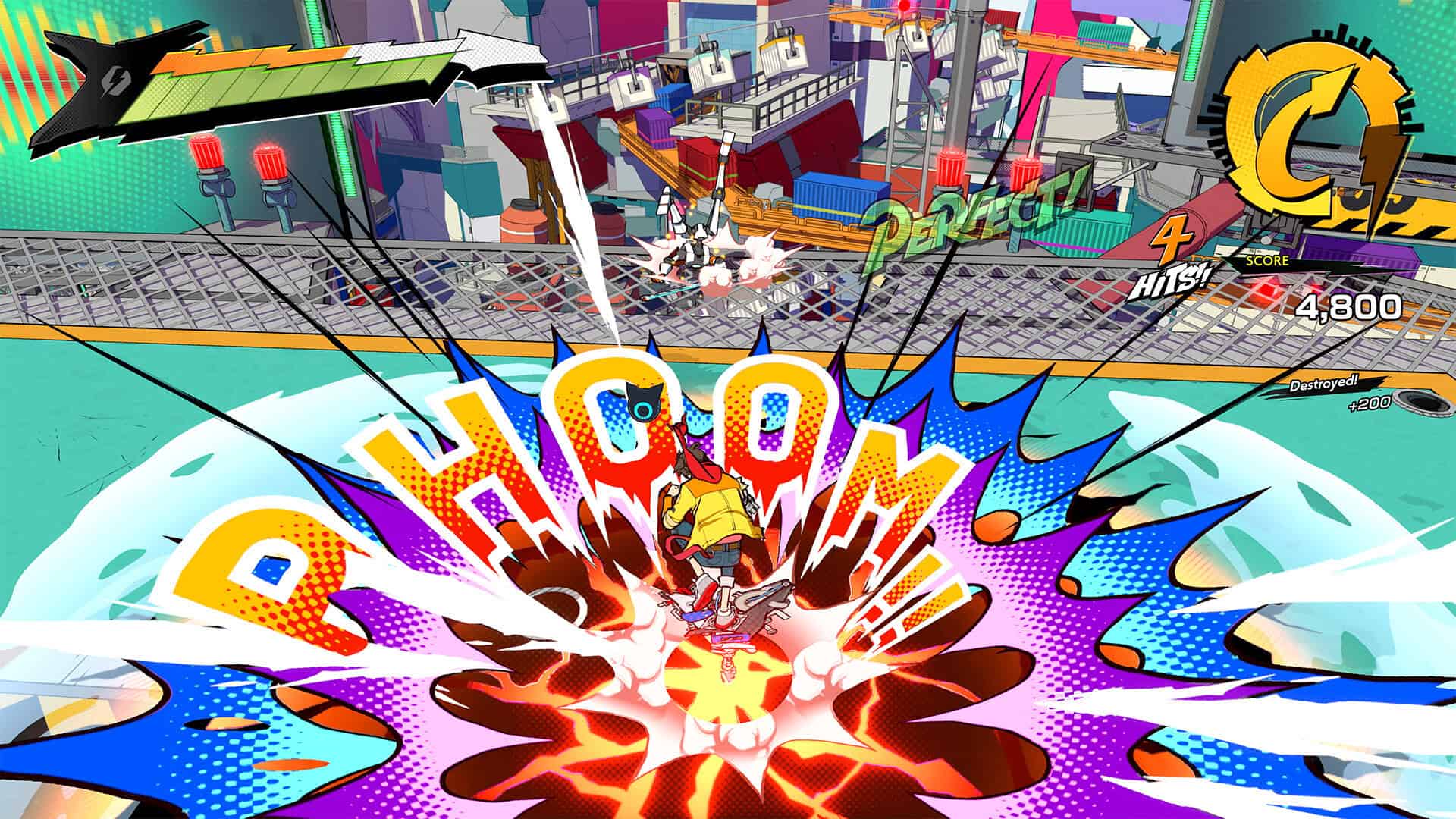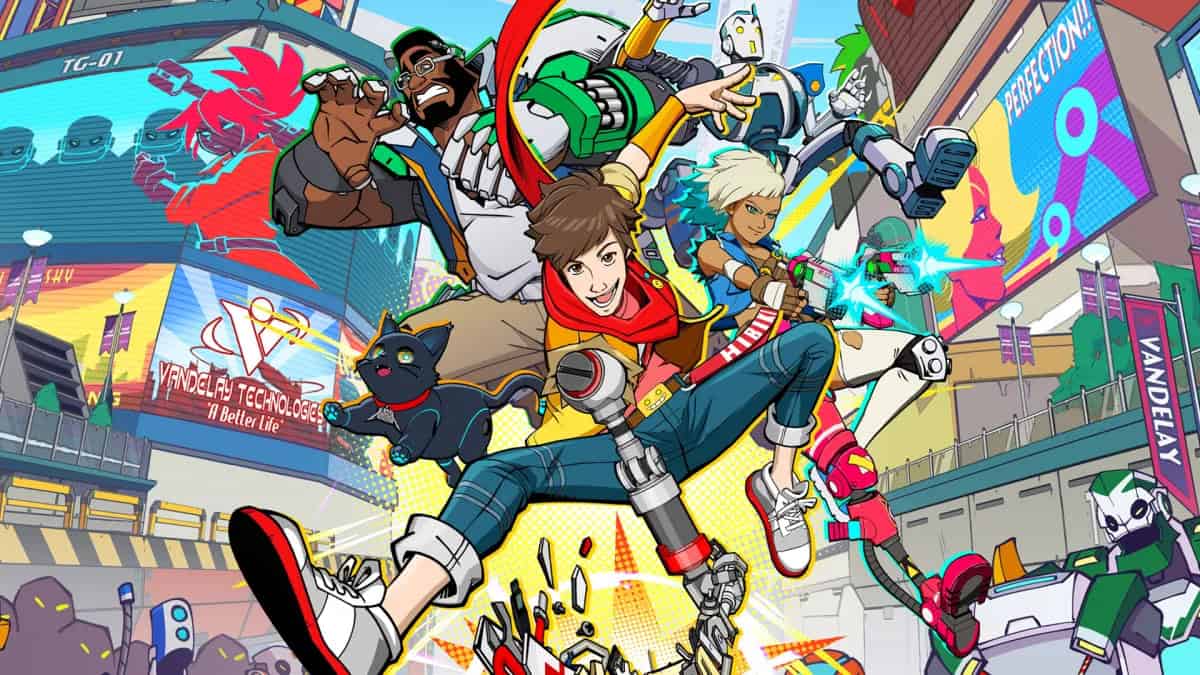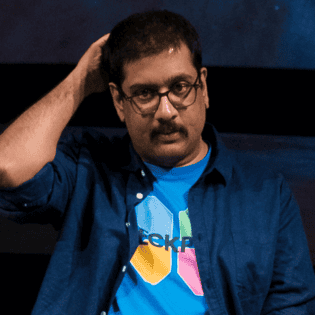Hi-Fi Rush made waves last month for releasing the very moment it was announced, and doubly so for being a fantastic game on its own merits (as per our glowing review). It’s a unique action game where everything you do syncs up to music, and you are rewarded for stylishly keeping up with the beat. It also features top-notch animation, a genuinely funny script, and a kick-ass soundtrack. With so many elements in one package, we got to chat to director John Johanas, who seemed excited to finally be able to talk about his game.
“I’m in a very complex emotional state right now,” said Johanas, on having to keep the secret for five years since Hi-Fi Rush started development in 2017. “It feels incredibly good to finally talk about the game, but it feels even better to talk about it in an environment where you can see a lot of people are enjoying it. It wasn’t a small project. There were a lot of people involved, a lot of cogs in the machine to get a product released, and for it to not leak. I mean, maybe someone did know about it but held back on purpose.”
But the secrecy seemed to have paid off, as the game exploded onto consoles without any prior knowledge. “It took a lot of planning, and a lot of people saying ‘Hey, don’t talk about this,’” chuckled Johanas, “but we were able to pull it off. Obviously from the developer’s side, you’re worried because it’s a new strategy, but the reception was extremely positive, so I think it went as good as any of us could’ve imagined.”
In fact, a lot of the initial praise the game received was what the team at Tango Gameworks was hoping to hear from all the way back in their original pitch. “Things like (being) accessible to people who don’t play rhythm games, being straight fun, or being a throwback to the Dreamcast, PS2, and original Xbox era, being a colourful, fun video game that didn’t take itself too seriously,” said Johanas. “You’d see quotes from our pitch docs. That’s extremely rewarding from the developer side that we were able to execute our vision how we wanted it to be and see the reaction be exactly what we also wanted. It’s incredibly satisfying.”
Tango Gameworks was previously known for the survival horror series The Evil Within and the spooky Ghostwire: Tokyo. Compared to them, Hi-Fi Rush seems like it was made by a totally different company, even though Johanas wrote the DLC chapters for the first Evil Within and directed The Evil Within 2. I asked why the choice was made to veer so strongly from what the studio was known for.
“My boss Mikami-san (Shinji Mikami, director of the first Evil Within) and I knew that we didn’t want to get pigeonholed into doing just one type of game, because we knew that we had the potential to do other things as well. It just felt right to try to pitch something out of left field at that time. We knew that maybe (publisher) Bethesda wouldn’t see us as capable of doing a game like that, but we were able to make a prototype and show that we had a strong vision for what the game could be.”
“As we were going into announcing the game, we thought that users who knew us for one type of genre may see that and have a knee-jerk reaction like ‘there’s no way they can pull this off, they only know how to do horror’. So that was the most positive thing about it being available after we launched it. People played it and saw that it was a high-quality product executing very strongly on its vision. It didn’t feel like an experiment, it felt like it was made by a team that was confident in their vision for what they wanted the game to be, and it was also very polished. I think there was a little bit of worry at first, but the further we got into development, the more we saw that it was turning out to be a good game. So, for anyone who’s worried about it: you don’t need to be worried, because, at the end of the day, a good game is the most important thing, not the developer’s previous history.”
“Everyone has that idea in their mind of that game they’d like to make.”
Though Hi-Fi Rush was first pitched in 2017, Johanas talked about how the early idea for the game was brewing in his mind for much longer. “It’s funny, we just spoke about this at work. Some people knew that I would bring it up from time to time. We were trying to date it, because we knew it was around development of the first Evil Within, someone said around 2012. But at that time the idea was just ‘hey, wouldn’t it be cool to fight to the music? Yeah!’ That was it.”
“And that comes with my background. I enjoy playing music, I obviously love music in general, but I’m the kind of person who, when I’m walking and listening to music, I walk in the same pace as the song. It percolated in my mind for a while, but I don’t think I understood the technical ability to pull it off until maybe I finished working on multiple projects before I could see. It’s not just a cool idea, this is how it could actually be executed. Everyone has that idea in their mind of that game they’d like to make, but if it’s challenging, you do need some experience to back that up, to make that into an actual product.”
Hi-Fi Rush also boasts evocative animation and art styles and seems inspired by anime and cartoons from the 80s, as well as character action games like Devil May Cry and Bayonetta. If the original concept was to fight to the music, when did all those other unique aspects come in?
“This is gonna sound half arrogant, and half like a lie,” started Johanas, “but most of it was in the original pitch document. The pitch for the story was about a music player implanted in your power unit, you’re called the defect by the company who does it, and you fight with a ragtag group of teammates to overturn a company, one boss at a time. The fact that it would be a colourful, almost comic book-esque world was also in the pitch document, as well as the 3D action and the music elements. And when we went to figure out the actual details, we found an art style that works with the game, and then we moved to make it feel like a cartoon.”

“When we found our first piece of key art, I said ‘This looks great. I want the game to look exactly like this image.’ We would show somebody this 2D image and when they’d say, ‘That’s cool concept art,’ we’d move the stick on the controller and be like ‘Nope, that’s the game.’ I think we got really, really close to that. I almost want to release the original concept art piece to show that the image we had is still in the game.”
“It’s funny that some limitations contributed to the look of the game. The scale of certain scenes was too big for the environment team to make, so we reached out to a 2D animation studio called Titmouse who helped storyboard those scenes that we interspersed within the game, but still keeping the rhythm. You probably see if you play the game, it cleanly goes from 3D cinematic stuff to 2D cinematic stuff then back to 3D. A lot of that stuff was created out of ‘We don’t know how to do this in 3D, so why don’t we just kind of cheat it?’. But when we put them in it felt really cool. It added to the experience, but it’s a good example of limitations actually helping out the experience.”
“A good game is the most important thing, not the developer’s previous history.”
After finishing Hi-Fi Rush, I noticed a familiar name in the credits. Masaaki Yamada is a prolific game designer who has worked on Devil May Cry, Bayonetta, and Okami, to name a few. I asked Johanas how Yamada’s influence affected Hi-Fi Rush’s final state.
“Yamada-san is obviously very skilled; he’s worked on the best of the best. When we were first making Hi-Fi Rush, he wasn’t yet part of our team. We were developing the action system, which is different from standard action games. It’s a bit more lenient, due to syncing with the beat. Since the early team didn’t have experience in action games, we didn’t have preconceptions on what to do, but when he came in, we were finally – I don’t know if converted or brainwashed is the correct word to use – into the type of game we made. He really helped us flesh out how to balance the combat system, as well as we introduce more elements to make it deep but not too challenging.”
Since feedback from other staff led to changes during the course of development, I asked Johanas if there was content he really cared about that had to get cut from the game.
“If you play the game, you know that we’re honest about the stuff that we cut. We reference it through one of my favourite RPGs from that period, Xenogears. We have a sequence where the characters just sit in chairs and talk about this event that probably would’ve been playable. We chose what was best for the game rather than getting everything in and making it feel like it was unfinished, so we wanted the stuff that was in there to be very high quality. We scoped it like every project does, the only difference is we acknowledged the fact that we scoped it in the game.”
“In other games you couldn’t do that, you’d have to hide it, but we’re more self-referential. It’s a playful attitude, so I feel like we can get away with it. It’s funny that normally some people get up in arms about cut content, but with us, it’s part of the experience.”

That experience is so finely curated, partially from Johanas being the sole credited writer. For my final question, I asked him about his experience writing the game, especially since it’s one of the funniest games I’ve personally played in a long time, sticking out in a landscape where humour is not something most games excel at.
“I had a strong vision where I wanted to write a game that was humorous, which I just enjoy writing in general, but also a game where the story wasn’t the main thing, it was more about the characters. I didn’t think the story needed to be bad, but the story needed to be simple, a way to make these very relatable or interesting characters, so that’s what stays with you more. For a game about character action, and a team of wannabe heroes and over-the-top villains, you want them to be more memorable than plot twists. It’s the characters that stick with you.”
“It feels incredibly good to finally talk about the game.”
“Humour is tricky, right? it doesn’t land with everyone, everyone has different sensibilities, so I think the people it did land with appreciate it. I’m sure there’s some people who say it’s not funny at all, but you can’t win ‘em all.”
“It’s more a matter of tone than the actual humour at points. We stuck to what the game is, so it feels like a complete package. We kept the scope and the tone compact and clear, so it wasn’t like the writing team was off writing a game, and they came back and said ‘How do we fit this into the game we’re making?’ Everything was interconnected, and we were always talking with each other, and I think that’s what makes it feel more of a complete package than maybe a game that’s larger in scope that can get out of hand and you feel like things are kind of put together.”
And a complete package is exactly what Hi-Fi Rush is. After the interview finished Johanas reminded me that even though I finished the game, I’ve still got more story to discover in the post-game content.
Hi-Fi Rush is out now on PC and Xbox Series X|S, including Game Pass.





